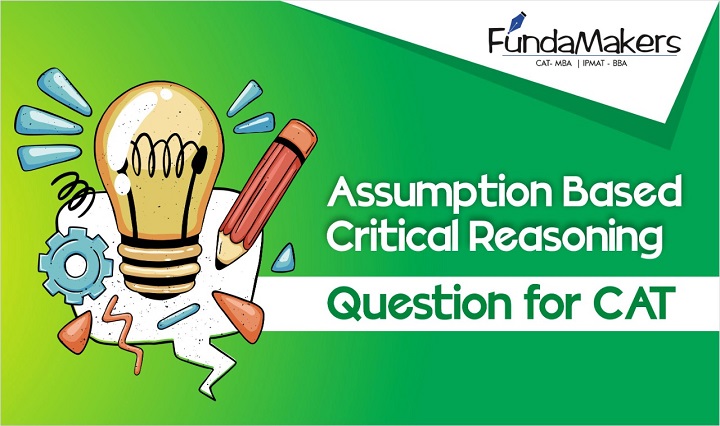How to solve Assumption Based Critical Reasoning questions for CAT
Critical reasoning questions for CAT Exam form a regular part of the Verbal Ability section. In these questions, an argument is presented and the candidates are asked to select the correct choice for a statement, related to the assumption/ true statement/ strengthening/ weakening/ plausible explanation pertaining to that argument, from the given answer choices. These types of questions examine a candidate’s logical skills and the ability to identify reason and rationale.
Though Critical Reasoning questions are not seen in past year CAT Exams but having a command over Critical Reasoning Questions will help in solving Reading Comprehension Questions for CAT and Verbal Ability Questions for CAT. In this article, we will be learning some tips and tricks to Solve Critical Reasoning questions for CAT and how to solve Assumption Based CR Questions for CAT Exam.
What are Premise, Conclusion, and Assumption?
Critical reasoning questions for CAT Exam comprise of a passage with several facts and an argument is given which will further comprise of a premise and a conclusion. The premise is a fact or proof related to the subject matter of the passage and usually, they are stated clearly by the author. In other cases, they are not explicitly stated but assumed and so they form the “Assumptions”. The questions related to this are “Assumption Based Questions on Critical Reasoning for CAT Exam”. A conclusion is an assertion or a point of view that the author wants to convey through the passage. This conclusion is an important part in the sense that most of the questions are linked to it. Whether it is the ‘strengthen/ weaken the argument’ or ‘inference-based questions’, all these imply the identification of the conclusion of the passage.
With reference to the Assumption-based questions, the Critical Reasoning section consists of a lot of questions related to it. They are used to test your ability to recognize the assumptions of an argument. An assumption, unlike a premise, is true only in respect of the argument as it might not be true per se. You have to assume what the author believes to be true.
Assumptions of any argument in a passage are mostly explicit. However, the questions asked in the exam are more of nature where the assumptions are not stated rather the candidates have to identify them on their own. This is because the passage in itself is left incomplete. Some facts remain unstated which makes it the job of the reader to identify its assumptions and its conclusion. There is a missing of some facts or there is a notable gap present in the argument.
There are two types of assumptions used to fill in that gap in the argument:
- A Sufficient Assumption: This assumption is one if inserted in the premises of the argument at the right place would complete the argument and make it meaningful. It gives a conclusive meaning to the argument with no gaps. For these type of assumptions, the questions can be asked in the following ways:
Which one of the following, if assumed, enables the conclusion of the argument to be properly drawn?
The conclusion follows logically from the premises if which one of the following is assumed?
- A Necessary Assumption: This type of assumption must be true in respect of the argument so that it can have a standing and not be refuted by counter arguments.
EXAMPLE | Assumption based Critical Reasoning Questions for CAT:
Argument: John comes to college in a Mercedes. He, therefore, must be rich.
The question that is asked about this argument is:
The conclusion follows logically if which one of the following is assumed?
To solve this question, you have to first identify the conclusion and the premises that support it. The conclusion in the above argument is “He, therefore, must be rich”, as is evident by the use of the word “therefore”. There is only one statement available in support of this conclusion, “John comes to college in a Mercedes”. This premise tells us only that John comes to college in a Mercedes car but in no way it points out that he is rich. Therefore, there is a gap between the conclusion and the above-stated premise. This gap must be fulfilled by an assumption that will render meaning to the whole argument. This assumption is the bridge. It will direct the flow of the argument logically from the premise to the conclusion.
John comes to college in a Mercedes. John, therefore, must be rich.
Assumption: Mercedes can be owned only by rich people.
The above assumption completes the argument logically.
Strategy for Assumption based Critical Reasoning questions for CAT
1. Identify the premise:
To solve any assumption-based question, firstly, you have to identify the premise given in the argument. The premise holds the key to understand what the argument is about or what the author is trying to convey. Note that the premise will be something that the author believes to be true. Do not let your personal beliefs let you think that something else is true which would cause you to choose the incorrect answer. Search for indicator words like owing to, for example, because, since, for, as indicated by, for the reason that, given that, we know this by, etc. to find the premise statement.
2. Identify the conclusion:
The next step after finding the premise is recognizing the conclusion of the argument. It can be identified by words or phrases like accordingly, hence, follows that, clearly, as a result, must be that, consequently, shows that, thus, so, etc.
3. Identify the Assumption:
An assumption is an unstated fact or assertion in an argument. It is stated implicitly which connects the premise and the conclusion. Once the premise and the conclusion have been identified, it is relatively easy to identify the assumption as well.
- Check the answer options first: We have to skip our personal beliefs in order to find the assumption which is based on what the author thinks to be true. So we should always first check the answer options given and not think of the assumption on our own.
- Method of negation: We should try to rule out or eliminate a given answer option after perusal to find out whether it can lead us to the conclusion or not.
Tips to solve the Assumption based Critical Reasoning questions for CAT
1. Assumptions must be true for the given argument:
The assumption should be true according to the author for a given argument and so read the statement with this approach only. The direction of the flow is that the assumption must be true for the conclusion to be true.
2. Do not be too logical with the arguments:
Read the information given and restrict your logic for identifying the assumption to the information provided in the argument itself and not beyond that.
3. Assumption cannot be deduced from the given information:
Unlike ‘inference’, the assumptions are new information and should not be deduced from the given information.
4. Do not align the argument with general knowledge:
The given argument may or may not be according to the facts known generally and so the same goes for identifying the assumption which must not be based on some general knowledge.
5. Use the elimination method:
When nothing works out, go through the given answer choices and eliminate them one by one. The assumption which connects the premise and the conclusion completely is the correct choice.
For complete playlist for Critical Reasoning Question Practice for CAT, follow this playlist:
CAT Resources:
To help you crack CAT-2021 with ease, we at Fundamakers is offering FREE Practise Sessions covering each and every topic related to Logical Reasoning & Data Interpretation (LRDI), Quantitative Aptitude (QA), and Reading Comprehension & Verbal Ability (RCVA)
Subscribe to our YouTube channel now!!
For 24×7 Doubt Resolving, join our Facebook Group: FundaMakers- CAT Prep
For Latest B-School Updates & much more, Join our Telegram Channel now!
Read More:
- Tips & Tricks to solve ParaJumble Questions in CAT
- Reading Comprehension for CAT | Tips to solve RCs
- Why, When & How to Take Mock Tests for CAT 2021
- Right time to start taking Mock Tests



